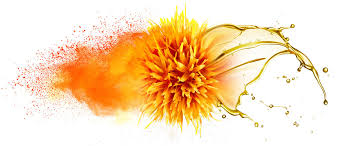Safflower Oil




Safflower Oil
Latin name: Carthamus tinctorius L,.
Family: Asteraceae (Compositae)
Etymology:
Tinctorius means of dyes or belonging to dyers. Carthamus is modern Latin and is derived from the Arabic quetum and the Hebrew qarthami, meaning to dye, to colour (reader's Digest 1985). Synonyms are American saffron, false saffron, bastard saffron, dyers' saffron.
The Plant and its environment
The safflower is a tall annual plant with an orange-yellow flower - hence the English name, which is a shortened form of saffron flower. It is related to the lettuce, sunflower, artichoke, chicory and daisy, and is sometimes referred to as American saffron (indeed, it has been used to adulterate saffron, hence another common name 'bastard saffron' ),. It is a plant of antiquity, and has always been highly regarded; safflower seeds have been discovered in Egyptian tombs up to 3000 years old. Both the flowers and the seeds have been used in the dyeing of material.
Producers include Mexico, India and the United States, although the quantities produced, while by no means insignificant, are far below that of the chief oil crops (Bruneton 1995).
The Oil :A fluid, unsaturated oil which is a pale to rusty yellow in colour, with a make up similar to that of sunflower oil.
Method of Extraction
Produced by cold expression of seeds.
Principal Constituents
| Type | Based on | Content - % |
| Saturated fatty acid units | ||
| C16:0 | Palmitic acid | 6-7.5 |
| C18:0 | stearic acid | 2-2.5 |
| Typical saturated fatty acid unit content | 9 | |
| Monounsaturated fatty acid units | ||
| C16:1 | Palmitoleic acid | 0.5 |
| C18:1 | Oleic acid | 20 (high 72-79) |
| Typical monounsaturated fatty acid un it content | 16 | |
| Polysaturated fatty acid units | ||
| C18:2 | linoleic acid | 77 (55-81) |
| C18:3 | linolenic acid | trace |
| Typical polyunsaturated fatty acid un it content | 76 |
Physical properties
| Odour | bland, little odour |
| Energy value | 903 |
| Iodine value | 140 150 (87 94 high oleic) |
Folk-lore and traditional Uses
The natural pigments safflomin and carthamine (or vegetable red) have a long history in dyeing and in the manufacturing of paints and cosmetics; it is used today in making of rouge and other make-up in Algeria. The leaves and seeds are capable of making milk curdle, thanks to a special enzyme . The oil has been used as a lamp oil. The flowers are laxative and diaphoretic ( Wren 1975).
Therapeutic properties - internal use
Use of safflower oil aids prevention of chronic degenerative diseases such as arteriosclerosis, arthritis and coronary thrombosis (Bartman1996) or those suffering with angina and circulatory problems. The oil is also helpful in cases of bronchial asthma and nephrosis. Safflower is reputed to have diuretic properties and safflower tea has sudofific properties ( ie it promotes sweating).
Therapeutic properties - external use
Eczema and rough skin (Bartram 1996)
Culinary use
The keeping qualities are poor and it is unstable at elevated temperatures it is therefore not good for most culinary purposes except as a salad dressing. It is however useful as a food supplement as it is a rich source of esential fatty acid.
Cautionary notes
Safflower oil has no known contraindications.
Reference: Carrier Oils for Aromatherapy and Massage: Len Price with Ian Smith & Shirley Price
Articles-Most Read
- Home
- Contact Us
- Coconut Oil-2
- Absorption Ratings for Carrier Oils
- Cold Pressing Method
- What are Essential Fatty Acids
- Cherry Kernel Oil
- Fixed Oils and Skin Penetration
- Hempseed Oil
- Almond Oil
- Cocoa butter
- Camelina Oil
- Coconut Oil
- Antibacterial Effects Of Carrier Oil
- Lime Blossom Oil (macerated)
- Carrot Oil, Wild Carrot Oil (macerated)
- Apricot Kernel Oil
- Kukui Nut Oil
- Jojoba Wax
- Pumkin Seed Oil - Cucurbita maxima, C. pepo
- Passion Flower OIl (Macerated)
- Hydrocotyle Oil (macerated)
- Rapeseed Oil - Carrier Oil
- Palm Kernel Oil
- Nutrients
Who's On Line
We have 118 guests and no members online
Articles-Latest
- How to Make Homemade Olive Oil: A Step-by-Step Guide
- 20 Evidence-Based Aloe Vera Oil Benefits For Skin, Hair & Health
- Peanut oil - Cold pressed - Are There Health Benefits? How To Make
- What Are the Health Benefits of Black Seed Oil?
- Comfrey oil Infused
- Chamomile Flowers Infused Oil
- Calendula Flowers Infused Oil
- Arnica Flowers Infused Oil
- How To Make Herb-Infused Oils
- DIY avocado oil for healthy skin
- How To Make Coconut Oil
- 8 Benefits of Mustard Oil, Plus How to Use It
- SHOREA STENOPTERA SEED BUTTER
- Shea Butter- 7 Amazing Benefits Of Shea Butter
- Monoi Oil For Hair & Skin
- Mango Seed Oil
- Cohune Oil Is The Next Big Thing
- Brazil Nut OIl
- 7 Impressive Benefits Of Allspice
- Camelina Oil Benefits, Uses, and Side Effects




